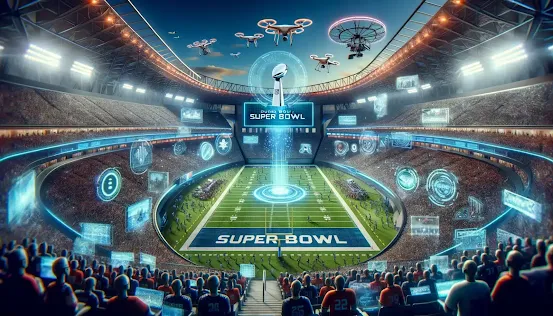
Introduction
Section 1: AI in Player Performance and Training
AI has revolutionized the way athletes train and perform.
Advanced machine learning algorithms analyze vast amounts of data from various
sources, including wearable devices, game footage, and biometric sensors, to
provide insights that were previously unimaginable.
- Wearable
Technology and Performance Analytics:
- Modern
wearables equipped with AI capabilities can monitor an athlete's vital
signs, biomechanics, and movement patterns in real-time. For example,
devices like the WHOOP Strap 4.0 and Catapult Sports' wearable
tech offer detailed data on an athlete's heart rate variability,
sleep patterns, and physical load, helping coaches tailor training
programs to optimize performance and prevent injuries.
- Computer
Vision and Skill Analysis:
- AI-powered
computer vision technology, such as Hawk-Eye Innovations, is being
used to analyze player movements and techniques. This technology breaks
down complex movements into smaller segments, allowing for precise
analysis of form and technique. For instance, in tennis, computer vision
can analyze a player's serve mechanics, providing instant feedback on
areas for improvement.
- Virtual
and Augmented Reality (VR/AR) Training:
- AI
is enhancing VR and AR technologies to create immersive training
environments for athletes. Tools like STRIVR and Rezzil use
AI to simulate real-game scenarios, helping players improve their
decision-making skills and mental agility without the physical strain of
actual gameplay.
Section 2: AI in Sports Injury Prevention and Recovery
Injuries are a significant concern in sports, and AI is
playing a critical role in minimizing risks and aiding recovery.
- Predictive
Injury Analytics:
- AI
algorithms analyze historical injury data, player load, and biomechanical
data to predict the likelihood of injuries. Platforms like Kitman Labs
and Zone7 use predictive analytics to assess injury risk, allowing
teams to modify training loads or provide rest to high-risk players
proactively.
- Rehabilitation
and Recovery Monitoring:
- AI-driven
rehabilitation tools, such as Physimax and RecoveryForce,
provide personalized recovery plans and monitor an athlete's progress
during rehab. These tools use machine learning to analyze movement data
and suggest specific exercises or treatments to optimize recovery.
Section 3: AI in Sports Strategy and Game Planning
Coaches and teams are increasingly relying on AI to develop
and refine their game strategies.
- Game
Footage Analysis:
- AI
tools like Hudl and Spiideo analyze game footage to
identify patterns and strategies of opponents. By breaking down video
frames and tracking player movements, these tools provide coaches with
actionable insights to develop counter-strategies and improve team
performance.
- Real-Time
Decision Making:
- AI
systems are now capable of providing real-time data during matches,
helping coaches make informed decisions. For example, tools like IBM's
Watson and SAP Sports One analyze live game data to suggest
tactical changes, substitutions, or adjustments in formation.
Section 4: AI in Fan Engagement and Experience
AI is not just transforming on-field performance; it’s also
enhancing the fan experience, making sports more engaging and interactive.
- AI-Powered
Fan Interactions:
- Chatbots
and virtual assistants, like SiriusXM AI Sports Chatbot, provide
fans with real-time updates, personalized content, and interactive
experiences. These AI tools answer fan queries, provide live match
commentary, and even predict game outcomes.
- Personalized
Content and Marketing:
- AI
algorithms analyze fan behavior to provide personalized content, from
targeted advertisements to customized highlight reels. Platforms like FanThreeSixty
use AI to understand fan preferences and deliver tailored experiences,
increasing fan loyalty and engagement.
- Enhanced
Viewing Experience:
- AI
is also enhancing the viewing experience by providing real-time
statistics, augmented reality (AR) graphics, and multi-angle replays.
Broadcasters like ESPN and Fox Sports use AI to offer
dynamic camera angles and in-depth analysis during live broadcasts.
Section 5: Ethical Considerations and Future Trends
While AI is revolutionizing sports, it also raises ethical
concerns, particularly around data privacy and the potential for bias in AI
algorithms.
- Data
Privacy and Security:
- As
more personal and performance data is collected from athletes, there is
an increasing need for stringent data privacy and security measures to
protect sensitive information from misuse.
- Bias
and Fairness in AI Models:
- Ensuring
AI models are free from bias is crucial, especially in areas like player
selection and performance evaluation. AI developers must focus on
creating fair algorithms that do not favor or discriminate against
certain groups.
- Future
Trends in AI and Sports:
- Looking
ahead, AI will likely continue to evolve, with advancements in predictive
analytics, AI-driven fan engagement platforms, and more sophisticated
virtual training environments. As technology progresses, AI could
potentially be used in areas like officiating, providing more accurate
and unbiased decisions.
Conclusion:
Artificial intelligence is undeniably changing the game in
sports. From enhancing player performance and preventing injuries to
revolutionizing game strategy and fan engagement, AI is set to play an even
bigger role in the future of sports. As teams, athletes, and organizations
continue to embrace AI, the sports industry will undoubtedly see even more
innovative and exciting developments. Embracing these technologies responsibly
will be key to unlocking their full potential and ensuring a fair and enjoyable
experience for everyone involved.
By staying informed about the latest AI trends and
developments, sports professionals can leverage these tools to gain a
competitive edge and provide fans with a more engaging and immersive
experience.






0 Comments